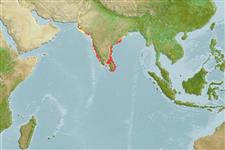Environment: milieu / climate zone / depth range / distribution range
Ökologie
seewasser; brackwasser; tiefenbereich 0 - 50 m (Ref. 188). Tropical; 26°N - 5°N, 63°E - 91°E (Ref. 188)
Indian Ocean: Karachi to Madras and perhaps north to Calcutta. Specimens from the northwestern coasts of Australia may be this species. Almost certainly mistaken in the past for the very similar Ilisha melastoma in Indian waters.
Size / Gewicht / Alter
Maturity: Lm ? range ? - ? cm
Max length : 18.0 cm SL Männchen/unbestimmt; (Ref. 188)
Rückenflossenstacheln (insgesamt): 0; Afterflossenstacheln 0; Afterflossenweichstrahlen: 40 - 47. Belly with usually 18 to 21 - 7 to 9, total 26 to 29 scutes. Eye large, lower jaw projecting. Dorsal fin origin a little before midpoint of body; anal fin origin below final dorsal fin ray bases. Vertical striae on scale with a distinct gap across center of scale. Flanks with faint dark band. Swim bladder with two tubes passing back in the muscles on either side of haemal spines.
Occurs in coastal waters, but probably also enters estuaries. Caught with Ilisha melastoma (Ref. 171). More data needed.
Life cycle and mating behavior
Geschlechtsreife | Fortpflanzung | Ablaichen | Eier | Fecundity | Larven
Whitehead, P.J.P., 1985. FAO Species Catalogue. Vol. 7. Clupeoid fishes of the world (suborder Clupeoidei). An annotated and illustrated catalogue of the herrings, sardines, pilchards, sprats, shads, anchovies and wolf-herrings. FAO Fish. Synop. 125(7/1):1-303. Rome: FAO. (Ref. 188)
IUCN Rote Liste Status (Ref. 130435)
Bedrohung für Menschen
Harmless
Nutzung durch Menschen
Fischereien: kleinfischerei
Mehr Information
NamenSynonymeMetabolismusRäuberÖkotoxikologieFortpflanzungGeschlechtsreifeAblaichenSpawning aggregationFecundityEierEientwicklung
ReferenzenAquakulturAquakultur ProfilZuchtlinienGenetikElectrophoresesVererbbarkeitKrankheitenVerarbeitungNutrientsMass conversion
PartnerBilderStamps, Coins Misc.LauteCiguateraGeschwindigkeitSchwimmstilKiemenoberflächeOtolithsGehirngrößeSehfähigkeit
Tools
Zusatzinformationen
Download XML
Internet Quellen
Estimates based on models
Preferred temperature (Ref.
123201): 27 - 28.6, mean 27.8 °C (based on 48 cells).
Phylogenetic diversity index (Ref.
82804): PD
50 = 0.5000 [Uniqueness, from 0.5 = low to 2.0 = high].
Bayesian length-weight: a=0.00871 (0.00397 - 0.01910), b=3.04 (2.87 - 3.21), in cm total length, based on LWR estimates for this Genus-body shape (Ref.
93245).
Trophic level (Ref.
69278): 3.4 ±0.5 se; based on size and trophs of closest relatives
Widerstandsfähigkeit (Ref.
120179): hoch, Verdopplung der Population dauert weniger als 15 Monate. (Preliminary K or Fecundity.).
Fishing Vulnerability (Ref.
59153): Low vulnerability (12 of 100).
